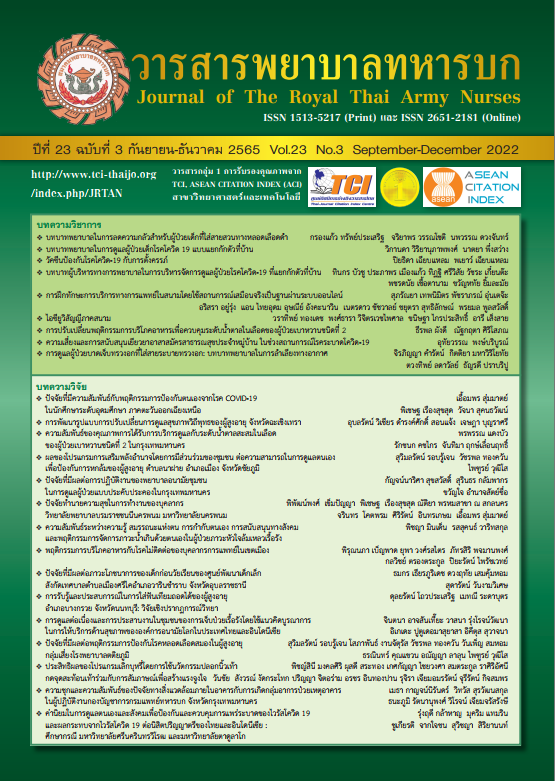The Effects of Community Participation Empowerment Program on the Self-Care Abilities in Fall Prevention among the Elderly in Na Fai Sub-district, Muang District, Chaiyaphum Province
Keywords:
Empowerment program, Community participation, The Self-Care Abilities, Fall Prevention among the ElderlyAbstract
This study was a quasi-experimental research with a one-group pretest-posttest design. The study aimed to examine the effects of community participation empowerment programs on self-acre abilities to prevent falls in the elderly. The study samples were 30 elderly people and 8 key informants of the empowerment in Na Fai Sub-district, Muang District, Chaiyaphum Province. Purposive sampling and inclusion criteria based on Gibson’s empowerment concept were used. The experimental group received 8-week empowerment program by community participation developed by the researcher.The program activities included providing knowledge and balancing test (Time Up and Go Test), home visits, exercise skill practice, and empowerment, supported by community leaders, health care personnel and relatives. Research tools used to collect data consisted of 3 sections: 1) personal information 2) environmental information 3) elderly self-care ability assessment form and the ability to manage the environment to prevent falls in the elderly. The treatment used in the experiment was an empowerment program by community participation. Content validity of the questionnaires was verified by 5 experts. The reliabilities of the instruments were 0.80, 0.79 and 0.80 respectively. The data were analyzed using frequency, distribution, percentage, mean, standard deviation, and paired-samples t-test.
The results showed that after participating in a community-based empowerment program, the elderly participants had higher mean scores of self-care ability and ability in managing the environment to prevent falls, and balancing ability compared to their baseline at the .05 statistical significance level.
Tambon Health Promoting Hospital should bring Community Engagement Empowerment Program to apply and expand the results in the elderly in the diabetic group, Hypertension and various chronic diseases to enable the elderly to have self-care behaviors to prevent falls sustainably.
Downloads
References
World Health Organization. WHO global report on falls prevention in older age. Geneva: WorldHealth Organization; 2008.
Department of Disease Control. Fall Forecast Report of the elderly (60 years and over) in Thailand (Year 2017 – 2021). Department of Disease Control, Ministry of Public Health; 2017. (in Thai)
Foundation of Thai gerontology research and development Institute (TGRI). Situation of the Thai elderly 2018. Bangkok: Print Terry ltd.; 2019. (in Thai)
World Health Organization. WHO Global Report on Falls Prevention in Older Age. Switzerland: Langfel designs.com. 2007.
Mahaprom T. , Monkong S. & Wongvatunyu S. Tai Chi practice and Its impact on elderly people’s balance. Thai Journal of Nursing Council 2017; 32(3) 50-65. (in Thai)
Health Systems Research Institute. The 5th Thai People’s Health Survey by Physical Examination 2014. Nonthaburi: Graphic and Design Alphabet; 2016. (in Thai)
Strategy and Planning Division. Death certificate 2012 - 2019. Office of the Permanent Secretary, Ministry of Public Health; 2019. (in Thai)
Gibson, C. H. The process of empowerment in mothers of chronically ill children. Journal of Advanced Nursing. 1995; 21(6): 1201-1210.
Cohen, J.M., and Uphoff , N.T. Rural Development Participation: Concepts and Measures for Project design, Implementation and Evaluation. New York: the Rural Development Committee, Center for International Studies, Cornell University. 1977.
Orem, D. E., Taylor, S. G., & Renpenning, K. M. Nursing: Concepts of practice (6thed.). St. Louis: Mosby. 2001.
Kittipimpanon K. & Kraithaworn P. The Effectiveness of Community-Based Fall Prevention Model to Physical Performance and Fall Among Older Adults In An Urban Community Bangkok: The Follow Up Study. Journal of Public Health Nursing 2015; 29(1): 98-113. (in Thai)
Shumway-Cook, A., Brauer, S., & Woollacott, M. Predicting the probability for falls in community dwelling older adults using the Timed Up & Go Test. Physical Therapy. 2000; 80(9: 896-903.
Cohen, J. Statistical power analysis for the behavioral sciences. (2nded.). USA: Lawrence; Erlbaum associates. 1988.
Frison L& Procock SJ. Repeated Measure in Medical Trials : Analysis using Mean Summary Statistics and its Implications for Designs. Stat Med. 1992.
The Fifth Health Center. The Effectiveness of Preparation and Fall Prevention Programs in Elderly training Center Education Medicine, Ratchaburi Province. 2019. (in Thai)
Leekitwattana P. Educational research methods. 11thed. Bangkok: Min Service Supply. 2016.
Podsiadlo, D., & Richardson, S. The timed “up & go” a test of basic functional mobility for frail elderly persons. Journal of the American Geriatrics Society. 1991; 39(1): 142-148.
Mahoney, F. I., & Barthel, D. W. Functional evaluation: The Barthel Index. Maryland state medical Journal, 1965; 14(1): 56-61.
Chanjirawadee P., Sirisopon N., Kainaka P.& t Onsiri S. The Effectiveness of a Fall Prevention Program for a Fall Prevention Behaviors in Hypertension Elderly. Royal Thai Army Nursing Journal. 2017; 18 (2):41-48. (in Thai)
Boonmatong R. Changmai S. & Hinjiranan S. Outcomes of self-Care program for elderly fall prevention in Samut Sakhon Province. Christian University Journal, 2015;21(3): 573 - 586. (in Thai)
Noopud P. Phrom-On D. Woradet S. & Chaimay B. Prevalence of Fall Risk and Factors Associated With Fall Risk Among Elderly People. Journal of Sports Science and Health, 2022;21(1): 125-137. (in Thai)
Downloads
Published
How to Cite
Issue
Section
License
Copyright (c) 2022 Journal of The Royal Thai Army Nurses

This work is licensed under a Creative Commons Attribution-NonCommercial-NoDerivatives 4.0 International License.
บทความหรือข้อคิดเห็นใดใดที่ปรากฏในวารสารพยาบาลทหารบกเป็นวรรณกรรมของผู้เขียน ซึ่งบรรณาธิการหรือสมาคมพยาบาลทหารบก ไม่จำเป็นต้องเห็นด้วย
บทความที่ได้รับการตีพิมพ์เป็นลิขสิทธิ์ของวารสารพยาบาลทหารบก
The ideas and opinions expressed in the Journal of The Royal Thai Army Nurses are those of the authors and not necessarily those
of the editor or Royal Thai Army Nurses Association.






